Several years ago I planted a little-known vegetable crop- physalis. She raised it, but didn’t know what to do with it. A little imagination and everyday experience as a housewife and gardener allowed me to diversify my table by preparing dishes from physalis.
I would like to add that with relatively identical agricultural technology for tomatoes and physalis, the latter does not suffer from late blight, which is especially noticeable in wet years, when tomatoes become very sick and the fight against late blight adds a lot of trouble.
For some reason, many gardeners don’t even know what it is. To get people interested, she brought prepared dishes to the local market, talked about cooking recipes and farming techniques, and treated neighbors and acquaintances.
Several recipes for dishes made from physalis were published on the pages of the magazine. I dare to offer my own recipes.
DISHES FROM BERRY PHYSALIS
Raisin. Ripe fruits are blanched in hot water, peeled from shells, laid out thin layer on film or cloth and dried in the sun or dried on a baking sheet in the oven at a temperature of 50-60 degrees. Dried physalis is used to prepare compotes, pilaf, puddings, and fillings.
Compote. The fruits are dipped in boiling water and then in cold water to get rid of bitterness and mucus, sugar is added to taste. You can add prunes, dried apricots or other dried fruits to physalis. Add to taste citric acid. Cook over low heat.
Jam. It can be cooked from both berry and vegetable physalis. Cut the washed fruits, pour in sugar syrup, cooled to 60-80 degrees, so that they are completely covered with syrup, and soak in it for 10-12 hours. To prepare the syrup, take 500 ml of water and 500 g of sugar.
After soaking the physalis in syrup, add 100 g of sugar per 1 liter of prepared syrup, boil for 8-10 minutes, set aside for 10-12 hours. Repeat three times, each time adding 100 g of sugar per 1 liter of syrup. At the end of cooking, add citric acid to taste.
Candied fruit. To prepare them, physalis is cut into 4 parts, then boiled like jam. Then, hot, they are thrown into a colander, the syrup is strained, allowed to dry a little, rolled in powdered sugar and laid out on a sieve with a cell diameter of 3-4 mm, shaken and excess sugar is removed. Place candied fruits on parchment paper and air dry, turning them over periodically.
DISHES FROM VEGETABLE PHYSALIS
Before preparing dishes from physalis, it is washed several times with water to remove the sticky, waxy substance.
Pickled physalis. The fruits are placed in layers in jars with spices: dill, horseradish, black currant leaves, cherry, tarragon, basil, parsley, celery, hyssop, oak leaves. For 1 kg of physalis spices in the total mass there should be no more than 50 g. Fill with brine.
The brine is prepared as follows: for 1 liter of water - 50 g of salt, 50 g of sugar, 1.5-2 tablespoons of 9 percent table vinegar. Pour boiling brine over the physalis and cover with a lid. Let stand for half an hour, then drain the brine and boil again. At this time, you can put chopped garlic in the jars.
Pour boiling brine into the jars and seal. Place the jars in the prepared place, cover with an old blanket and pillows for 10-12 hours. Such preparations are stored throughout the winter and even for several years.
Salted physalis. Physalis can be salted with cucumbers, coarsely chopped cabbage, red and yellow bell peppers. All this is placed in layers in jars with spices, as indicated in the previous recipe. Prepare the brine: 60 g of salt per 1 liter of water.
Pour physalis with brine and leave to ferment for 7-10 days. Then drain the brine, strain it and boil. Fill the jars again with boiling brine, roll them up and place them under a blanket.
Vegetable caviar. Bake the prepared fruits, pass through a meat grinder, adding salt and ground pepper to taste. Purified onion, carrot, bell pepper fry in a deep frying pan until soft, mince, add salt and a little sugar to taste, mix with prepared physalis.
When preparing for winter storage jars of caviar must be sterilized: half-liter jars - 10 minutes, “seven hundred” jars - 15 minutes, liter jars - 25-30 minutes.
Jam. Pour blanched and finely chopped physalis fruits with 1 glass of water, put on low heat and boil, gradually adding sugar. For 1 kg of fruit - 1-1.2 kg of sugar. Stirring, cook until done. The jam should be jelly-like.
Physalis jam. The fruits are blanched for 2 minutes, then boiled for 15-20 minutes in a small amount of water. If desired, you can add cranberries, rhubarb, red or black currants, rowan, and rose hips to the puree.
Cool the puree after boiling for 25-30 minutes, rub through a sieve or pass through a juicer to remove the peel, add sugar to the mass in a 1:1 ratio and cook over low heat, stirring constantly.
Marmalade. For the marmalade, prepare the puree as indicated in the previous recipe, add citric acid and vanillin to it, leave the puree over low heat, stirring constantly. Boil the mass to a residual moisture content of 35-40%. After cooling, you get an excellent jelly - marmalade.
There are vegetable (Mexican) physalis, strawberry (berry) and ornamental physalis. The fruits of Physalis vegetable and berry are eaten. Physalis fruits ripen, depending on the variety and type, 80-100 days after sowing. The lower ones ripen first. They can be collected as soon as the berries acquire a characteristic color for the variety, and the covers begin to lighten and dry out. Ripe physalis fruits fall to the ground and in dry weather can lie there for 7-10 days without spoiling.
Cleaning and storing physalis
Physalis fruits are collected gradually, about once a week: first, fallen and ripe ones, and then well-developed green ones. The main thing is to have time to collect the fruits before frost, since frozen fruits are poorly stored. Do not pick fruits after rain or until the dew has dried. Before storing physalis, the berries need to be dried. Physalis, harvested in dry sunny weather, is stored better. To ensure that physalis spoils less during storage, try not to damage the berries when harvesting. Undamaged fruits better retain the substances that determine the taste and aroma of each variety.
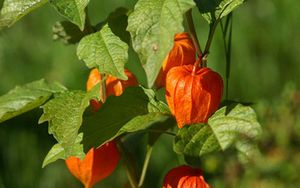
It is best to store physalis in a cool, dry place, in small boxes with ventilation holes or, containing no more than 3 kg of berries. At a temperature of +12-14°C, ripe fruits last 1-2 months. Unripe but healthy physalis fruits can be stored longer, sometimes until spring. At higher temperatures, fruits ripen faster and spoil faster: at a temperature of +25-30°C, ripening takes 1-2 weeks. Throughout the storage period, physalis should be regularly reviewed, choosing ripe fruits and throwing away spoiled ones.
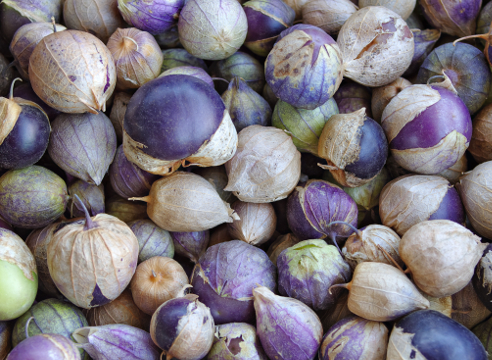
What to cook from physalis fruits
For “sweet” purposes, physalis is used mainly. It is suitable for making jam, marmalade, candied fruits, and jelly. It can be dried and used instead of raisins. Unlike vegetable physalis, berry fruits do not require blanching before consumption, since they do not have a sticky substance on the berries.
Physalis is a little known fruit. For most housewives, it remains a mystery how to marinate physalis. But true craftsmen know how to pickle physalis. If we compare it with vegetables, then the green tomato will be the most suitable in terms of taste. But physalis is more tender, and marinating physalis at home will not require much of your time.
On our website you can also find pickling recipes, as well as ones that will not leave you indifferent.
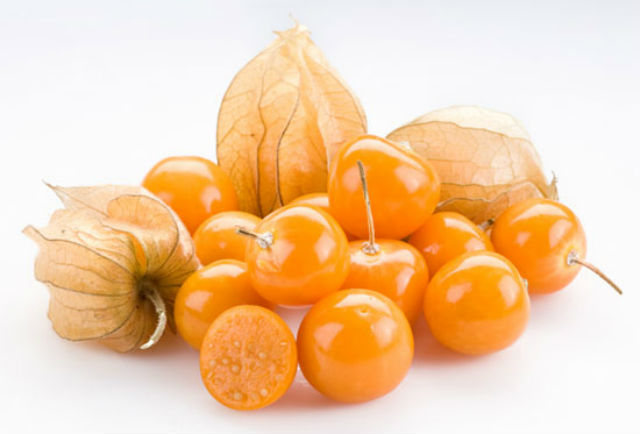
Pickling physalis for the winter is very simple, since the technology is very similar to pickling regular tomatoes. Yes, and you can store jars of physalis in a regular pantry; it is not at all necessary to transfer them to the cellar or refrigerator.
You will need:
- half kg. physalis;
- 5 buds of cloves;
- 1 clove of garlic;
- 5 pieces. allspice and peas;
- 1 laurel leaf;
- 2-3 cherry branches;
- horseradish leaf;
- 1 no heap tsp. regular salt;
- 2 tsp. Sahara;
- 1 tbsp. l. vinegar.
How to pickle physalis for the winter:
- The berries are washed alternately in running water, bad and deformed specimens are selected.
- Spices and chopped garlic into thin slices are placed in sterile jars that have already been washed with soda.
- Only after adding spices are the jars filled with ripe physalis berries.
- Sugar and salt are poured over the top of the main ingredient.
- Each jar is carefully poured with boiling water so as not to burst and infused for at least twenty minutes.
- As soon as the time required for heating has expired, the water is poured back into the pan.
- Manipulation with boiling water is carried out three times.
- Only after completing the third pour is vinegar mixed with water.
- Now all the jars are securely rolled up and turned over. To carry out additional sterilization, the jars are also wrapped.
Important! You can determine how ripe the physalis is by the color of the box in which it is wrapped. Berries ready for pickling have a gray, thin shell. These are the ones that should be chosen to create a unique taste of previously unfamiliar preserves.
How to pickle physalis with plums
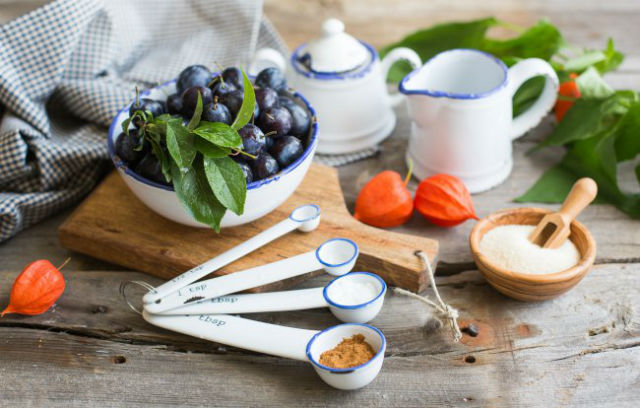
The original combination of physalis with sour plums will definitely appeal to lovers of olives and black olives. The taste of such preservation is in many ways similar to this expensive product, only physalis is much more affordable, can be grown in the garden without any problems and does not require special care. The technology for growing this fruit is practically no different from the one used to grow tomatoes.
You will need:
- half kg. physalis;
- 200 gr. drain;
- third tsp cinnamon;
- 5 clove buds;
- 3 pcs. allspice;
- 1 PC. hot pepper;
- 1 laurel leaf;
- 5 glasses of water;
- 2 tbsp. l. Sahara;
- 2 tbsp. l. regular salt;
- 1 tsp. acetic acid.
Pickled physalis recipes:
- Each fruit is pierced with a match in the place where it is attached to the cover.
- The berries are blanched for a couple of minutes so that the stickiness that cold water it is almost impossible to wash off.
- After heat treatment, the product is rinsed in cold water and wipe off with a dry and soft towel.
- All the necessary spices are laid out in each of the jars, which have already been washed with soda and sterilized.
- The cooled physalis and plums are laid out as tightly as possible in the same jars.
- The marinade is being prepared. To do this, water is boiled and sugar and salt are added to it; at the end of the process, all the necessary acetic acid is poured in.
- The marinade is poured into jars.
- The jars are covered with lids treated with boiling water and undergo sterilization for ten minutes.
- At the final stage, the jars are securely rolled up and covered with a regular towel.
Important! When preparing physalis for pickling, certain difficulties may arise due to the presence of a rather viscous, wax-like shell that is unpleasant to the touch. It is very difficult to wash it off with regular water. It’s better to just immerse the berries in well-boiling water for a couple of minutes. After this treatment, the shell can be easily removed by wiping with a regular dry towel.
Pickling physalis for the winter
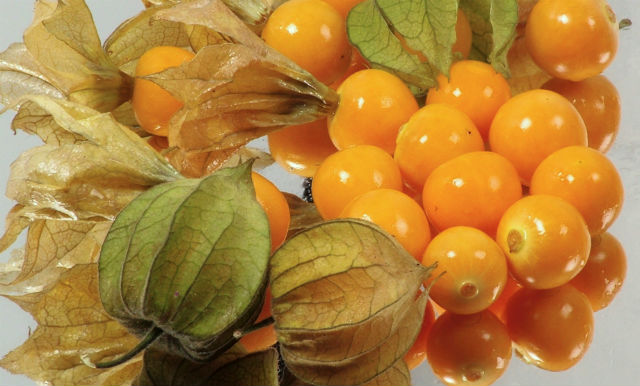
This marinade has a special charm. Fruits pickled according to this recipe acquire a very unusual taste and a delicate, summer aroma. Opening a jar of such physalis in winter means finding yourself momentarily in summer garden, with ripe fruits and blooming flowers. What could be better in the winter cold?
You will need:
- 1 kg. Mexican physalis;
- 16 clove buds;
- 16 pcs. allspice;
- quarter 200 gr. glasses of vinegar;
- 40 gr. regular salt;
- 60 gr. Sahara;
- 100 gr. spice mixtures;
- 5 glasses of water.
Marinated vegetable physalis:
- Physalis is washed thoroughly.
- All spices and spices are placed in equal quantities in jars.
- The prepared berries are ironed on top.
- Salt and sugar are poured on top of the physalis.
- Water is boiling on the stove, which needs to be poured into jars and left for 10 minutes.
- When the time allotted for heating the contents of the jars has expired, the water is poured into the pan and boiled again.
- The process is repeated again.
- Before the third, final filling, vinegar is added to each jar and the contents are filled with boiling brine.
- The jars are rolled up with lids and turned over. They should be wrapped so that they do not cool down too quickly.
Important! There are several ways to sterilize jars of physalis. In the first option, jars of berries are filled with boiling marinade and undergo a fifteen-minute heat treatment in a pan of boiling water. The second involves pouring boiling water over the contents several times. Each housewife has the right to choose the option that is more convenient for her. This will not affect the taste and safety of the product in any way.
How to pickle vegetable physalis
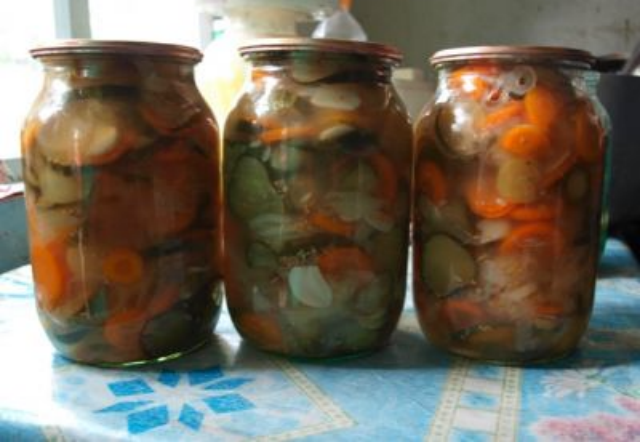
This solution will be ideal if there is not a lot of physalis, but you still want to pickle it. Lovers will really like this kind of preservation. canned salads. The result is a tasty and nutritious dish that will perfectly complement any side dish.
You will need:
- 1 kg. physalis;
- 1 kg. cucumbers;
- half kg. carrots;
- half kg. Luke;
- 5 heads of garlic;
- 10 pieces. black pepper;
- half a glass of sugar;
- 40 gr. regular salt;
- half a glass of fruit vinegar.
How to pickle vegetable physalis:
- The carrots are peeled and cut into thin rings.
- The cucumbers are chopped with a knife into pieces that best match the size of the physalis.
- The berries are doused with boiling water and wiped with a soft cloth.
- The onion is cut into half rings, and the garlic into slices.
- All prepared vegetables and physalis are mixed, the remaining unused components are added to them.
- The mixture is infused until the juice is released and then boiled for a quarter of an hour.
- The finished product is placed in jars that are already sterile and washed with soda.
- To complete the canning process, the jars are rolled up and turned over.
Important! Sterilization is an integral part of any preservation. Physalis is no exception. It is worth paying close attention to this process, since it depends on it whether the workpieces will last until winter.
This is interesting: marinated physalis can be added when fermenting cabbage, the fermentation process is reduced several times, and the taste acquires an islandy, piquant hue. It is also used as one of the dominant ingredients in all kinds of salads, both prepared for the winter and fresh.
Pickled vegetable physalis
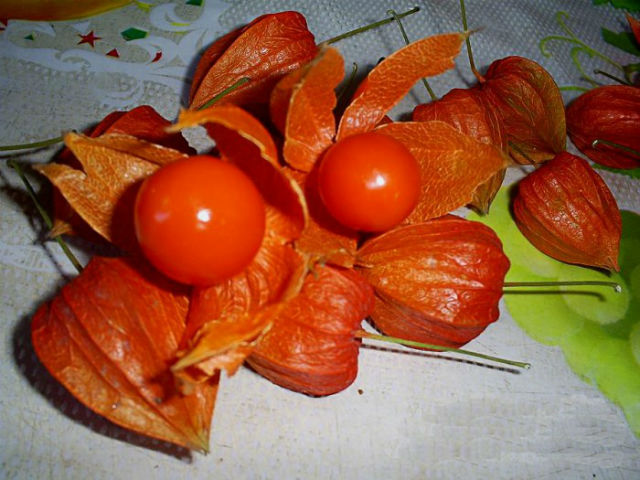
It’s impossible to describe how delicious pickled berries canned in tomatoes turn out. Such a dish does not stagnate on the table for a long time; it is eaten instantly. Therefore, it is better to immediately roll it up in larger jars.
You will need:
- 1 kg. physalis;
- one and a half liters tomato juice;
- 1 PC. horseradish root;
- 2 laurel leaves;
- a pair of currant leaves;
- 3 tbsp. l. Sahara;
- 50 gr. celery;
- 3 without a mound of art. l. regular salt;
- a pair of dill umbrellas;
- 5 pieces. black pepper;
- 3 cloves of garlic;
- 1 aspirin tablet.
How to deliciously pickle physalis:
- The berries are removed from the thin shell and blanched in boiling water for several minutes.
- Juice is prepared from tomatoes. They are cut into slices and boiled for about a quarter of an hour, after which they are thoroughly ground using a sieve.
- Spices, salt and sugar are added to tomato juice. The liquid should boil for a couple of minutes.
- The jars are prepared, washed with soda and sterilized.
- Currant leaves, chopped horseradish root, dill, celery and garlic are placed in each jar.
- Each jar is filled as tightly as possible with prepared physalis.
- An aspirin tablet is placed on top of the fruit and all ingredients are poured with hot tomato marinade.
- At the final stage, the jars are rolled up and turned over. They should also be wrapped to ensure high-quality sterilization.
Important! For the pickling process, not only the so-called vegetable varieties of physalis are used, but also berry varieties. Despite the natural sweetness of the latter, they acquire a certain sourness and even bitterness when interacting with acid and spices. Although more often the berry variety is used for drying and sweet preparations.
It's incredible how many people grow physalis solely as an ornament to their yard. You can make simply delicious preparations from it. In addition to pickling, there are many recipes for making jam, jam, compote and even marmalade from these berries. They make excellent, unusual-tasting caviar. This product is very beneficial for the body, and accordingly, dishes prepared from it are of particular value.
Vegetable physalis - very beautiful and useful plant. All its parts contain a large number of biologically active substances. Its fruits contain carbohydrates, various sugars, pectins, organic acids, carotenoids, ascorbic acid, tannins, micro- and macroelements. They have antiseptic, anti-inflammatory, hemostatic, diuretic, analgesic effects.
But I want to consider this interesting fruit from a culinary point of view. I prefer that in addition to the benefits, you can also experience the pleasure of using it. You can make a lot of physalis fruits various dishes, jam is made from it, desserts are made, it is salted, pickled, and used in salads.
So, marinated vegetable physalis, recipe:
Ingredients
- physalis
- dill
- garlic
- currant leaf
- black peppercorns
- allspice peas
- Bay leaf
For the marinade:
- salt, granulated sugar, vinegar
Method for pickling vegetable physalis
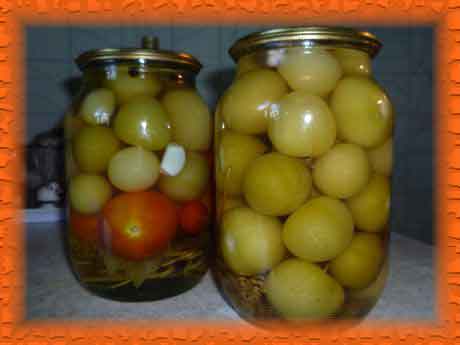
At the bottom of a jar with a capacity of 0.5 to 1 liter (it is better to preserve physalis in a small container), place dill stems, currant leaves (2-4 pieces), 1-2 cloves of garlic, and the rest of the spices. Place physalis fruits on top, previously peeled from the shell and thoroughly washed in warm water to remove as much wax as possible from the surface of the fruit.
Pour boiling water over and leave to brew for about 10-15 minutes. After the specified time, pour the water into a saucepan, boil, and pour the same water over the physalis again, for another 10 minutes. Then drain the water a second time, this time to directly prepare the marinade. When draining the water from the jars a second time, use some kind of measuring cup, because the marinade recipe is calculated for 1 liter. For example, before pouring the marinade into the pan, drain it into liter jar or into a measuring cup.
So, pour the water into a saucepan, add 1 tablespoon of salt and 3 tablespoons of granulated sugar per 1 liter, and boil. After boiling, add 0.5 cups of vinegar 9%. Pour the hot marinade into the physalis for the third time, roll up the lids, turn them over and wrap the jars with something warm. Slow cooling acts as additional sterilization. That's all!
P.S. You can add other vegetables to the jar of physalis, for example, cucumbers or tomatoes.
Cooking time: 1 hour 30 minutes
04 September 2014 645
There is a saying about this plant: the new is the well-forgotten old.
About 2 decades ago, gardeners became extremely interested in physalis.
The fruits were presented as an alternative to tomatoes.
It’s a pity, but then this plant did not become widespread, although it appeared in Europe at the same time as tomatoes.
The Indians, on the contrary, were indifferent to tomatoes and favored physalis.
Since the plants are related, their diseases are similar and they suffer from attacks by the same pests.
Vegetable plants that precede Physalis are cucumbers and cabbage.
The natural properties of this plant are identical to those of tomatoes.
These fruits cannot replace the universally adored tomatoes, but they can add variety to the assortment of vegetables in the garden.
Physalis is a nightshade plant.
Central America is considered its homeland, from there it came to North America, and in the seventeenth century to Europe and Asia.
According to various estimates, there are up to 115 varieties of ornamental and wild physalis.
There are 2 types of Physalis:
- Vegetable is larger, contains few dry substances, and is not very tasty in its raw form. It ripens quickly, has a high yield, is resistant to low temperatures, has such beneficial properties as analgesic, hemostatic, anti-inflammatory, choleretic and diuretic;
- Strawberry - small fruits, contains a lot of dry substances that make the taste more pleasant. It is used for making jams, marshmallows, can be dried, eaten raw, and also has beneficial properties.
Composition of Physalis

It is bred in the Caucasus, the Baltic states and Central Asia.
The flowering period is from May to August, and harvesting starts in June and ends in September.
Thanks to the fruits, this plant became so called (“physo” - from Greek “swollen”), because the spherical berry bright color placed in a bubble-shaped cup.
If you get a chance to try this unusual fruit, then you will not be able to help but notice how its pleasant juice perfectly quenches your thirst.
This is the result of the fact that one of the components of physalis is clean, fresh water.
It also contains a huge number of components that are beneficial to human health.
The main ones are micro and macroelements, electrolytes.
It is rich in organic acids, which normalize the acid-base balance.
The fruit of the Physalis pineapple variety, in addition to the indicated substances, has a high percentage of pectin and lycopene, which are strong antioxidants.
When consuming this fruit, the body receives astringents, fiber, steroids, vitamins A and C.
The substances necessary for humans are found in the above-ground parts, but all of its above-ground growing parts, except for the berries, are toxic and cannot be eaten.
The benefits of physalis
All parts of the plant consist of many useful substances that have beneficial properties.
The berries contain:
- carbohydrates;
- sugar;
- pectins;
- organic acids;
- carotenoids;
- vitamin C;
- binders;
- electrolytes.
Leaves contain:
- carotenoids;
- esters;
- steroids;
- cholesterol;
- phenolcarbolic acids;
- flavonoids.
Physalis berries have the following properties:
- disinfectant;
- anti-inflammatory;
- improves blood clotting;
- pain reliever;
- diuretic;
- choleretic.
Unprocessed fruits and juice are used in the treatment of:
- respiratory organs;
- hypertension;
- skin problems;
- dysentery.
A water tincture or decoction of berries is used for:
- cystitis;
- kidney stones;
- liver diseases;
- bronchitis;
- swelling;
- ascites;
- joint diseases;
- rheumatism;
- bruises.
A decoction of rhizomes is used as an antitussive and pain reliever.
Tea made from the leaves and shells of physalis is useful for high blood pressure.
Contraindications associated with eating berries
Physalis, despite the fact that it has a number useful properties for our body, it also has contraindications for use.
People with gastric problems should use it with extreme caution; it is better to start consuming it with two berries, slowly increasing the dose.
The caps and leaves of this plant can be used externally to treat wounds and sprains.
All parts growing above the ground are toxic, and if the dosage is violated, they can cause harm to health; treatment is carried out only after consulting a doctor and under his guidance.
Several delicious dishes using physalis

We invite you to view several recipes for physalis with its beneficial properties.
Physalis jam with ginger.
To prepare you will need:
- physalis - 1kg;
- sugar - 1.2kg;
- ginger (fresh) - 20g;
- water - 200g.
Clean the physalis.
Pour boiling water over the fruits, wipe dry and prick with a fork.
Wash the ginger, peel it, cut it into thin pieces, pour boiling water over it, cook for 1 minute and, adding sugar in small portions, cook syrup with this broth.
Immerse the prepared physalis berries in the syrup removed from the heat, leave for 1 hour and then cook over moderate heat until it becomes transparent.
Remove the shell from it, rinse, pour boiling water over it and wipe each berry.
Cut the fruits into pieces, add sugar, let it brew for 2 hours until the juice appears.
Then put on a hot stove, boil, cook for 10 minutes.
Grind the resulting composition using a sieve.
Place the mixture on a baking sheet and cook in the oven for 20 minutes.
When the composition is ready (it should not stick to the spoon), pour it in a thin layer onto the foil and dry.
The mass should be elastic and thin, easily separated from the foil.
Sprinkle the finished mixture with nuts.
Wrap it in a roll, cut it into pieces and put it in a box.
The finished dish can be kept at room temperature for several years.
Ripe physalis fruits are consumed unprocessed as fruit.
They can be used for preservation, sauces, jams, candied fruits, and marinades.
They can be added to tomatoes, cabbage, apples, plums when preparing pickles and jams.
Boiled physalis berries are used to prepare fillings for pies and decorate cakes.
The juice of this plant is used to season meat and fish dishes.
Fresh juice or pulp from berries can be eaten with cottage cheese, tea, jelly, etc.
Video dessert
In this video, they will tell you brief information about physalis, how to grow it and care for it.




